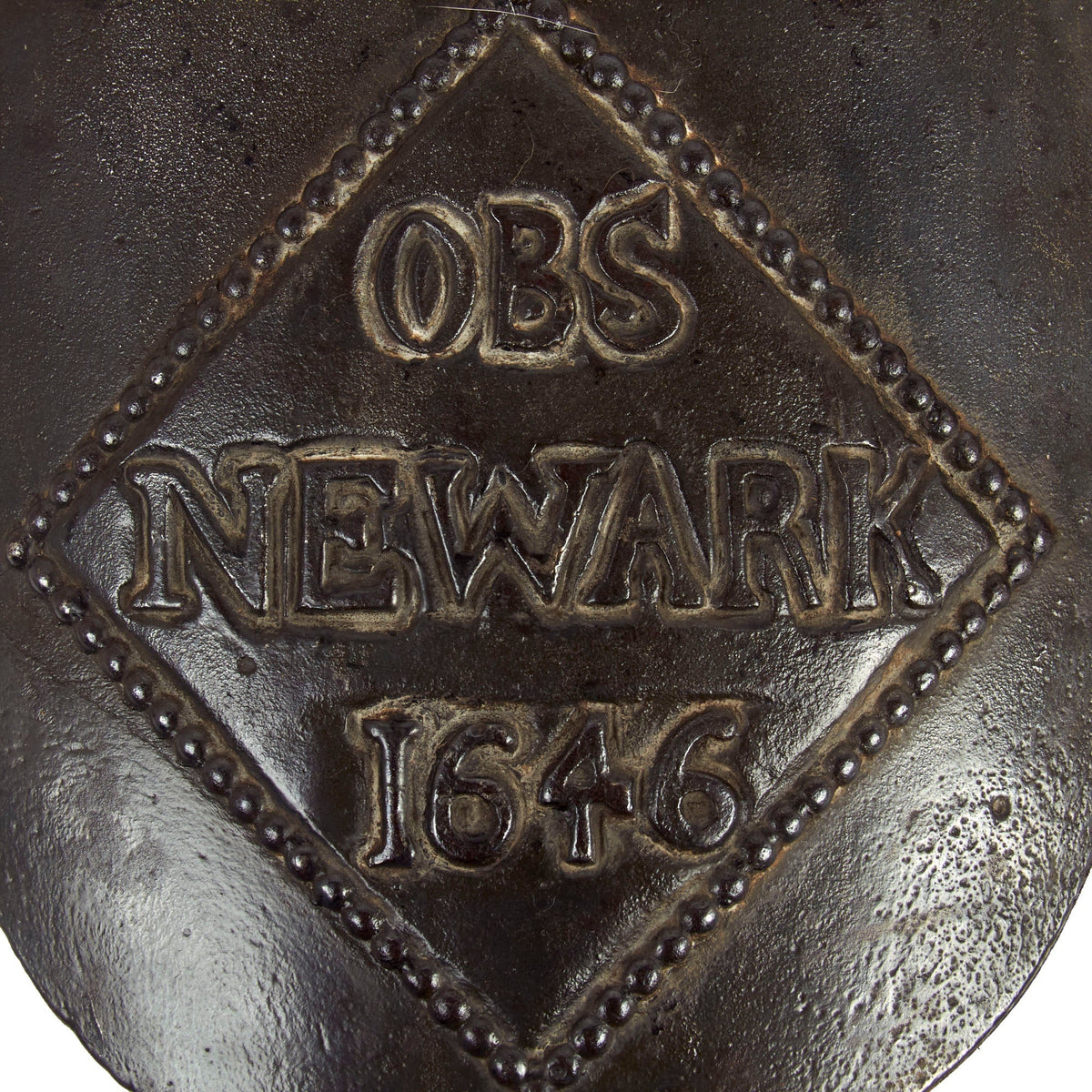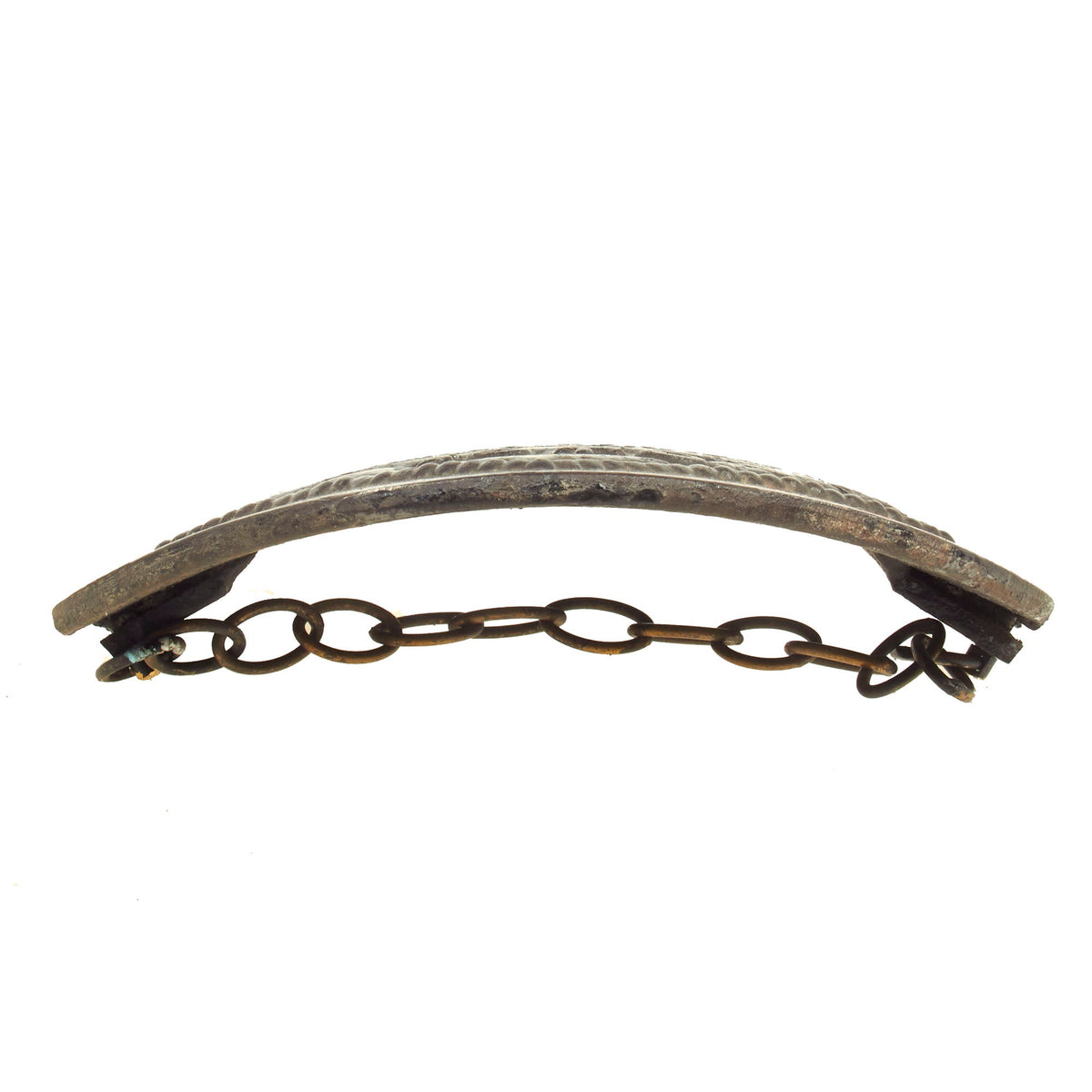Original 19th Century English Civil War Siege of Newark 1646 Iron Bridge Plaque Set Original Items
$ 495,00 $ 148,50
Original Items: One-of-a-kind set. Dating from he late 19th century this is a set of cast iron plaques replicating the Siege coins made in Newark on Trent during the English civil war. OBS an abbreviation of Obsidium which is latin for siege. These plaques were removed from Newark Trent Bridge during renovations around 1970. The bridge was built at the turn of the 20th century so we believe these to be the original plaques dating from that time. Each shield measures 10.75″ tall x 11.25″ wide x .25″ thick and weighs 10 lbs. Two mounting bracket’s are welded to the reverse of each and a brass chain was added to hang for display purposes. Each shield reads:
OBS
NEWARK
1646
These marks are contained within a raise diamond pattern and are identical to coins minted at the same time during the siege.
In addition to defeating Royalist forces in the field during the English Civil War Period (1642-1651), Parliamentarian commanders also at several points during this same period besieged those strategically important and heavily fortified Royalist centers. Among these centers, the most important was the city of Newark-on-Trent (commonly shortened to Newark). Located between the rivers Trent and Devon, and at the intersection of the Great North Road and the ancient Fosse Way, the city was a mainstay of the Royalist cause. Because of this, it was the subject of three attacks. The first attempt occurred in February 1643 when Major-General Thomas Ballard, at the head of 6,000 Parliamentarians, tried to take the town, but, realizing his force was insufficient for success, withdrew after a battle of only one day. Following this event, the city repaired its existing castle and medieval walls, and a new circuit of earthwork banks and ditches was constructed. Combined with the natural barrier offered by the River Trent, Newark became an impregnable fortress.
In early March 1644, a force of Parliamentary troops, this time under the command of Francis, Lord Willoughby of Parham and Sir John Meldrum, laid siege to Newark. Seizing control of the level area to the northwest of the city – an area known as “the Island” – the Parliamentarians attempted on 8 March to break through, but were repulsed by the city defenders; at the same time, a Royalist force, sent from nearby Belvoir Castle to relieve the city, was beaten back. Under the direct order of King Charles I, Prince Rupert on 12 March, hurried toward the city. Along the way, he acquired what Royalist forces he could. Rather than simply relieving the siege of Newark and allowing the Parliamentarians the opportunity to withdraw and return at a later time, Rupert’s plan was to destroy the besieging army. Beginning in the early hours of 21 March, Rupert’s forces advanced upon the Parliamentarians and forced them to become hemmed in on “the Island”. Now, surrounded by the Royalists and with no recourse for either maneuver or withdrawal, the besieging Parliamentarians began to mutiny. Calling for a parley, the Parliamentarians were allowed to march away, but without their artillery, firearms, and ammunition. Upon Rupert’s departure, the surrendered ordinance was incorporated into the city’s defenses, while the Parliamentarian command center during the siege was demolished and in its place was constructed a massive defensive earthwork.
The relief of Newark in March 1644 allowed the city to become a staging area for Royalist raids throughout the Midlands for the rest of that year. The events of 1645, however, were to contribute to this vital stronghold’s undoing. In May 1645, Sir Richard Willys, an ally of Prince Rupert, was appointed new governor of Newark. In mid-June, however, the main Royalist force under Charles I was soundly defeated at Naseby by the Parliamentarian New Model Army of Oliver Cromwell and Lord Thomas Fairfax. Following a second Royalist defeat at Rowton Heath in late September and his subsequent withdrawal from Chester, Charles withdrew to Newark in October 1645. Now, with his command structure beginning to disintegrate because of a conflict with Prince Rupert and the removal of Sir Richard Willys as governor of Newark, and the Parliamentarian forces hot on the king’s heels from Chester, Charles, in early November, withdrew to Oxford. In place of Willys, Charles appointed Lord Belasyse as governor of Newark. Anticipating an imminent attack, Belasyse ordered the city to be resupplied, as well as the construction of additional earthwork defenses – including a ditch around the entire town and the destruction of all buildings outside the perimeter. Beginning at about the same time Charles was departing, the Parliamentarian forces under the command of Sydenham Poyntz moved up from the south, massacring and plundering their way toward Newark. The siege of the city itself began in earnest on 26 November 1645 with the arrival of the main body, consisting of Parliamentarians and Scottish Covenanters, under the command of Alexander Leslie, the Earl of Leven. Over the next five months and with a defensive force of less than 2,000 men, Belasyse conducted a vigorous defense. At times, the defenders even conducted raids against the besiegers; in one raid, Sydenham Poyntz himself was almost captured. By the spring of 1646, however, the tide had begun to turn against the defenders. The Parliamentarian besiegers began contracting their siege lines while the Scottish Covenanters established a fortress – Fort Edinburgh – on “the Island”. By mid-March, Newark was entirely surrounded and cut-off from access to the outside. In April, the Scots captured a Royalist work called Sandhills Sconce, which they converted into a battery from which they could bombard the town. Through all of this, however, Belasyse refused to surrender.
While Newark was close to being stormed, diplomatic negotiations, led by the French, had been ongoing to secure an end to the war and the surrender of the king to the Scots, rather than Parliament. In early May 1646, with the New Model Army closing in on Oxford, Charles fled to the Scottish camp outside of Newark, where he surrendered himself to Lieutenant-General David Leslie, acting commander of the Covenanter army. Eager to transport the king to Newcastle-on-Tyne, a place which was more secure and closer to the Scottish border, but unwilling to appear as if he had abandoned his Parliamentarian allies, Leslie urged the king to order the immediate surrender of Newark on reasonable terms. Although Lord Belasyse is said to have wept when he received the order, he had no choice but to obey. Newark surrendered on 6 May 1646 and Belasyse marched out with his much-reduced garrison. On 8 May, the Scots broke camp and marched north, taking Charles I with them in semi-captivity.
Fast Shipping with Professional Packaging
Thanks to our longstanding association with UPS FedEx DHL, and other major international carriers, we are able to provide a range of shipping options. Our warehouse staff is expertly trained and will wrap your products according to our exact and precise specifications. Prior to shipping, your goods will be thoroughly examined and securely secured. We ship to thousands clients each day across multiple countries. This shows how we're dedicated to be the largest retailer on the internet. Warehouses and distribution centres can be located throughout Europe as well as the USA.
Note: Orders with more than one item will be assigned a processing date depending on the item.
Before shipping before shipping, we'll conduct a thorough inspection of the items you have ordered. Today, the majority of orders will be delivered within 48 hours. The delivery time will be between 3-7 days.
Returns
The stock is dynamic and we cannot completely manage it because multiple stakeholders are involved, including our factory and warehouse. So the actual stock may alter at any time. It's possible that you may not receive your order once the order has been made.
Our policy is valid for a period of 30 days. If you don't receive the product within 30 days, we are not able to issue a refund or an exchange.
You can only return an item if it is unused and in the same state as the day you received it. You must have the item in its original packaging.
Related products
Uncategorized
Uncategorized
Uncategorized
Uncategorized
Uncategorized
Uncategorized
Band of Brothers ORIGINAL GERMAN WWII Le. F.H. 18 10.5cm ARTILLERY PIECE Original Items
Uncategorized
Uncategorized
Uncategorized
Uncategorized
Uncategorized
Uncategorized
Uncategorized
Uncategorized
Uncategorized
Uncategorized
Angolan Rebel 1970s era 60mm Inert Display Mortar from Angolan Civil War Original Items
Uncategorized
Armored Burgonet Helmet & Polearm from Scottish Castle Leith Hall Circa 1700 Original Items













































































